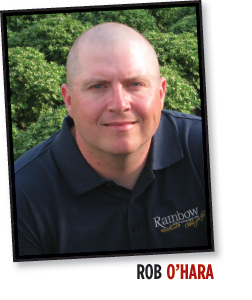4/27/2011
Growers Talk Production: The Dos and Don’ts of Trimming Liners
Rob O'Hara

Trimming plugs and liners is something that has been done for years and is nothing new to most greenhouses, but with new equipment and proper techniques, trimming is quickly becoming one of the important and cost-effective steps in growing a plant.
Over the last several years, the amount of cuttings versus seed items that we’re growing has shifted heavily towards the vegetative side. With the number of new genetics that we’re producing, we had to learn how to best control the growth of the liner. At first the ideas were all centered on PGRs; we were spraying and dipping and drenching plugs like crazy to try and keep them compact in the plug tray. This was all fine and dandy until we started planting and realized that some cultivars didn’t want to grow or branch out very well after they were planted.
As an alternative we started using scissors on some varieties, giving them haircuts instead of using PGRs. This proved to be effective, but very labor intensive. That led into our first homemade trimming machine (pictured). We used this machine for about three years until we graduated into a bigger AgriNomix model this year, which I love (pictured)!
There are three main reasons to trim your liners:
1 | Reduction of PGRs before planting. This allows the plants to get a quicker start after transplanting, which is especially useful for hanging baskets and planters.
2 | Better branching and fuller pots. When most plants are trimmed it allows the plugs to branch out more, giving you a nicer, fuller plant at the end.
3 | Labor savings. Once the plants have been trimmed, you can often save yourself a pinch later, which will translate into a labor savings.
Some of the mistakes we’ve made with our trimming:
1 | Trimmed just before planting. If you’re going to use a trimmer, make sure that you build enough time into your schedule to allow the plants to recover from the trim before you plant. A plant that’s just been cut in half is in too much shock and stress for it to grow well. We’ve seen crop delays in fuchsia, osteos, calie and the list goes on. Give the plants at least one week from trim to plant and you’ll be happier with the results.
2 | Trimmed too early. If you trim the plants too early you don’t allow for all the cuttings to stretch up enough so that all the tips are trimmed, which will make for very uneven trays and you’ll need to do it again. If you don’t re-trim, you’ll have plants pinched on different dates, which means that they’ll start growing unevenly and cause you problems on the bench.
3 | Trimmed more than once. Try to avoid trimming trays more than one time before transplanting. Sometimes there are exceptions to this rule, but we try to stick to this. If you’re trimming more than once, it probably means you’re not planting on time. We found that when you do more than one trim, some plants have a harder time after transplanting. For example, some of our fuchsias this year had two trims in the tray and we found that they were very slow to start and delayed the crop by two weeks. We’re assuming the plants just didn’t have the root system to support the number of shoots that were developing.
4 | Trimmed plants that should be pinched after planting. Not all varieties respond well to trimming—it’s important to find out which ones are best suited to trimming and which ones aren’t. We’ve found out this year that it doesn’t pay to trim osteos in the tray before planting. It leads to uneven branching, added labor in grading and re-pinching in the pot, and a very noticeable quality reduction. We found that varieties such as petunias, dahlias and impatiens are best pinched after planting.
Whether you’re using scissors or a fancy machine, trimming plugs is another tool that a grower has to use to produce the best-quality plants possible. But like any other tool it must be used properly to get the best end results.
GT
 Left: Rob’s homemade liner trimming machine ...
Left: Rob’s homemade liner trimming machine ...
Right: … now he uses an AgriNomix machine for all of their trimming.
Rob O’Hara is the head grower for Rainbow Greenhouses in Chilliwack, British Columbia, Canada.